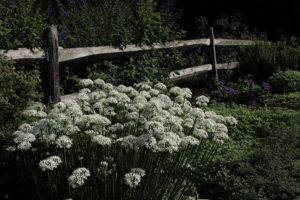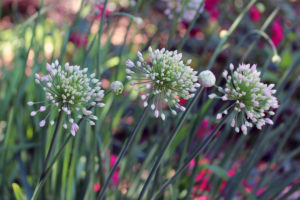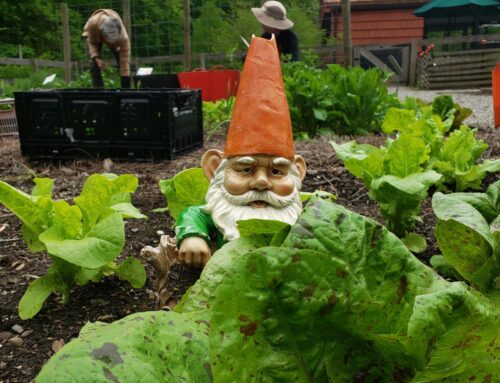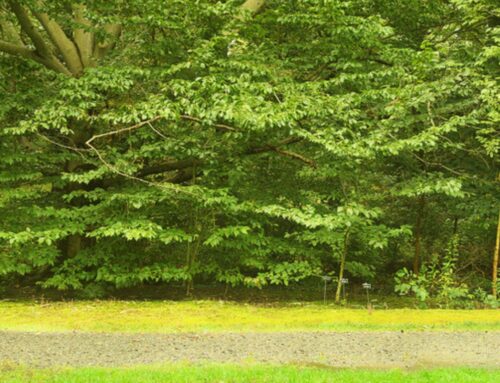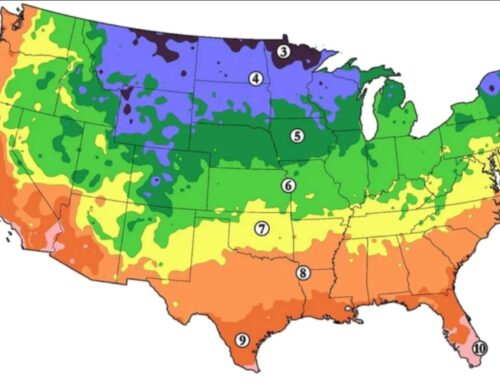If there ever was a plant-it and forget-it vegetable for your garden, it’s garlic. Why? Because garlic is easy to grow, has a high success rate, requires little maintenance, and is easy to harvest. Plus, it keeps away vampires (smiling? I hope so – seasonal joke)!
Some argue against planting garlic in your home garden with a comment like, “Why would anyone grow a vegetable that takes up to 295 days or 10 months from planting to harvest when you can easily and relatively cheaply buy it at the store?” What the commentator fails to consider is the average store has a very limited number of garlic varieties (usually softneck “California Early”) and not much more. I say to you, is not variety the spice of life?
You can also plant garlic as a means of pest control (and to scare away first dates you don’t want to see again). Plant it around the perimeter of your peppers, tomatoes, or blueberry bushes, and it will deter rabbits, squirrels, and some insects. Old school growers also recommend planting garlic near roses to keep Japanese beetles and aphids at bay.
Garlic has a long, much-loved history. Native to Central Asia and northeastern Iran, it is a common seasoning worldwide and has been for thousands of years. It was known to ancient Egyptians and has been found in pyramids and ancient Greek temples. In many cultures, garlic was administered to provide strength and increase work capacity for laborers. Garlic was given to the original Olympic athletes in Greece, as perhaps one of the earliest “performance enhancing” agents. The use of garlic as a food and as a medicinal agent has ancient origins in Asia. The best estimate is that around or before 2000 BCE, garlic was in wide use in China and formed part of the daily diet, particularly when consumed together with meat. In ancient Chinese medicine, garlic was prescribed to aid respiration and digestion and to deal with diarrhea and worm infestation. Today, China produces 76% of the world’s supply of garlic.
Garlic is divided into two main subspecies: the softneck (Allium sativum) and hardneck (Allium ophioscorodon). There are two major varieties under the softneck subspecies, and nine under the hardneck subspecies totaling 11 major varieties. Each variety has various name selections and cultivars, which vary in flavor more than you might think. If we total all the named cultivars, they would count up to the hundreds.
One thing that is commonly true about garlic is that all types pair well with all cooking applications and share the same medicinal properties.
As a rule of thumb, if your area has winters with hard frosts and snow, grow a hardneck variety. If you live in a mild climate, grow a softneck variety.
Home gardeners should avoid planting garlic bought at a local supermarket, as it may be treated with chemicals that inhibit sprouting. Another concern is that the store-bought variety of garlic may not be adapted to your local weather conditions and thus will fail after sprouting.
Order a variety of garlic from a seed catalog that’s recommended for your area.
To give you a little glimpse into the varieties out there that are suitable for our area (Zone 7), we can look at the types of garlic Lucille’s Garden is planting this fall: Music, Chesnok Red Bogatyr, Red Russian, Nootka Rose, Dog House, Montana Giant Georgian Crystal, Siberian, and Russian Giant.
Now, onto the when, where, and how to plant garlic. In the Mid-Atlantic and Northeast U.S., that means planting in October for harvest in July. Planting of garlic should be four to six weeks before a hard frost (not the first frost, which can occur earlier than the first ‘hard’ frost). Planting at this time helps the bulb germinate and get roots established before winter sets in. Depending on how warm fall is, you may or may not see shoots emerge till spring.
Before planting, it is good to work about two inches of compost into your garden soil so plenty of nutrients are available for the garlic come spring. Garlic should be placed in your garden where it receives full sun (at least six hours a day), so it can have the energy necessary to produce a bulb. Your garden soil needs to be well-drained, rich in organic matter, and have a neutral PH (between 6 and 7).
When it comes to the planting process:
- Separate the cloves from the garlic bulb, leaving the papery skin intact.
- Dig up and loosen 6-8 inches of soil, plant the garlic cloves with the pointy end up 2-3 inches deep, 4-6 inches apart, and in rows 12 inches apart.
- Mulch the planted area with 2-4 inches of straw, compost, or leaf mulch. This will stabilize the temperature of the soil over the winter and thus avoid frost heave, which will wreak havoc on the garlic cloves and newly formed roots.
- Water, but be careful not to overwater during the fall. Unless fall is dry as a bone, normal rainfall is usually sufficient to encourage root development.
Tip: To protect the garlic cloves from fungal disease and to jump-start growth, soak the cloves in one quart of water mixed with one tablespoon of baking soda and one tablespoon of liquid seaweed for two hours before planting.
- Early in the spring, pull up the straw or leaf much to allow the soil to warm and dry.
- Remember garlic, like most vegetables, needs one inch of water a week during the growing season.
- Fertilize your garlic every two weeks as leaf growth begins, and continue until mid-May when the bulbs begin to form. The best fertilizer for bulbs is one tablespoon of liquid seaweed mix and one tablespoon of fish emulsion mixed in one gallon of water.
- Around mid-June, your garlic will develop curly, flowery tops which eventually straighten into spikey tendrils (known as scapes). Remove them to encourage larger bulb growth. Scapes can be saved to introduce a garlic flavor in pesto and salads, rather than thrown into the compost pile.
- Sometime around midsummer (July), right about the time tomatoes are maturing, the tops of garlic leaves will begin to turn pale and wither. When roughly 1/3 of the leaves have browned, the garlic is ready to harvest. When harvesting, don’t yank the garlic out by its tops or you will be left with only leaves and no garlic. Instead, use a digging fork or shovel, carefully loosen the soil, and then pull the plants. Shake the soil from the bulbs, but do not brush it off with your hand. Garlic fresh from the ground is very delicate and can bruise easily.
- Lay the entire plant – tops, roots, and all with clinging soil – in a dry, warm, airy spot that is protected from direct sunlight and rain (such as a covered porch). Plants will take one to two weeks to properly “cure”, after which you can brush off the soil from the bulbs, and then clip the roots to about ½ inch.
- Allow the plants to cure for another week, and then clip off the stem. Do not remove the papery outer wrappers until you’re ready to use them, as they protect the bulb in storage.
- Store bulbs in a mesh bag in a cool dry area, as you would sweet potatoes. When stored at 50-60 degrees (F), most hardneck garlic varieties will last six months, and most softneck garlic varieties eight months or more. Do not store garlic in the refrigerator.
Tip: The garlic you plant will fine tune its growth pattern to your local climate, so save cloves from the bulbs you planted and replant them in the fall for reliable growth and better flavor.
In case you haven’t yet been convinced to plant garlic, I’ll share with you excerpts from my interview with the 2018 and 2019 garlic-eating champion and Garlic King of the Pocono Garlic Festival.
Charles Mattson has these encouraging words when it comes to garlic:
“Garlic enhances everything, except maybe cake.”
“One clove of garlic is never enough for anything. In any recipe double the amount of garlic.”
“Eat garlic for the wonderful, exciting, and sometimes pungent taste it brings.”
“Spice up your life – eat garlic!”
Have no fear, my friends. A toothbrush and mouthwash can render you fit to go public. Hope to see you in the garden, with or without garlic breath.


